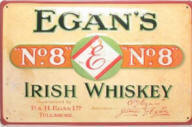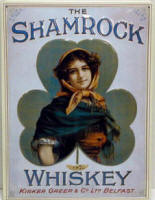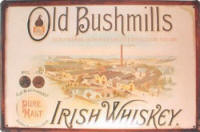| The History |
|
Ireland's History of Whiskey Distilling is long and rich of ups and downs. It is believed that Irish Monks brought the technique of distilling perfumes back from their travels to the mediterranean countries about 1000 A.D. The Irish modified this technique to obtain a drinkable spirit. Many centuries later, distilling was brought to Scotland via Campbeltown and the Island of Islay.
The first licenses for distilling in a certain region were granted in 1608. By the late 18th century, about 2,000 stills were in operation, two thirds of the output of which being considered from illegal distillation. When Alfred Barnard visited Ireland in 1885 researching for his book "The Whisky Distilleries of the United Kingdom",
the number of legal distillers had shrunk to 28. At the time, Irish Whisky was considered the finest in the world. The distilleries, most notably in Dublin, were huge enterprises with annual outputs of up to 2,000,000 gallons
(9 Million Litres) of "Pot Still" as the original
The Dublin "Big Four", John Jameson & Son of Bow Street, John Power & Son of John's Lane, George Roe & Co. of Thomas Street, and Willam Jameson & Co. of Marrowbone Lane, had a combined output of 5 Million Gallons per year, compared to an average of below 100,000 gallons at their fellow distilleries in Scotland. Further famous distilleries included Jones Road and Phoenix Park in Dublin, Daly's in Tullamore - still famous today for its "Tullamore Dew" - Cassidy's in Monasterevan, and John Locke's Distillery in Kilbeggan. However, a chain of unrelated events caused the tragic decline of this great industry: Firstly, the invention of the Patent Still by Aenas Coffey (an Irishman) was grossly rejected by the proud Irish distillers, but widely adopted by the Scots who went on blending their Whiskies, secondly, the institution of the Irish Free State in the early 20th century caused a fatal trade war with Great Britain, closing down the Irish Distillers' main market, as finally did the US Prohibition declaration in 1920. In those years, most of the smaller establishments closed for good. Only the larger companies were able to shut down production and wait for better times. In the 1930s, Old Midleton Distillery produced only for two weeks per year.
Today, only one of the original 28,
Bushmills Distillery in Co. Antrim, Northern Ireland, is still there producing, though being forced to close and re-opening a couple of times during its history.
This changed in 1987, when Cooley Distillery was founded by John Teeling in Riverstown near Dundalk, Co. Louth, which remains independent until today. Together, Cooley, Bushmills, and Midleton produce more than a 100 different Irish Whiskey brands today, amongst them the famous Jameson, Power's, and Paddy, as well as Connemara, Tyrconnell, and Kilbeggan. Surprisingly, the old defunct Distilleries have not vanished for good: Even in the Dublin of the 21st Century, traces of its once 6 Distilleries, as well as those throughout the country, can still be found. |
 Distilling
was considered a birthright by the Irish, and the introduction of tax on the
Whiskey (Excise) in the 17th century caused a centuries-long conflict between
the "Moonshiners" (illicit Distillers) and the Excisemen who enforced the tax
collection. In 1781, private distillation was banned by the UK government, and
excisemen were allowed to seize Whiskey, Whiskey-making equipment, and even
horses and vehicles used for transportation.
Distilling
was considered a birthright by the Irish, and the introduction of tax on the
Whiskey (Excise) in the 17th century caused a centuries-long conflict between
the "Moonshiners" (illicit Distillers) and the Excisemen who enforced the tax
collection. In 1781, private distillation was banned by the UK government, and
excisemen were allowed to seize Whiskey, Whiskey-making equipment, and even
horses and vehicles used for transportation. Irish Whiskey was called.
Irish Whiskey was called.  The Republic of Ireland Distilleries only survived by means of consolidation, which did the three remaining ones,
The Republic of Ireland Distilleries only survived by means of consolidation, which did the three remaining ones,